We produced our first proper “client” work back in October 2011:
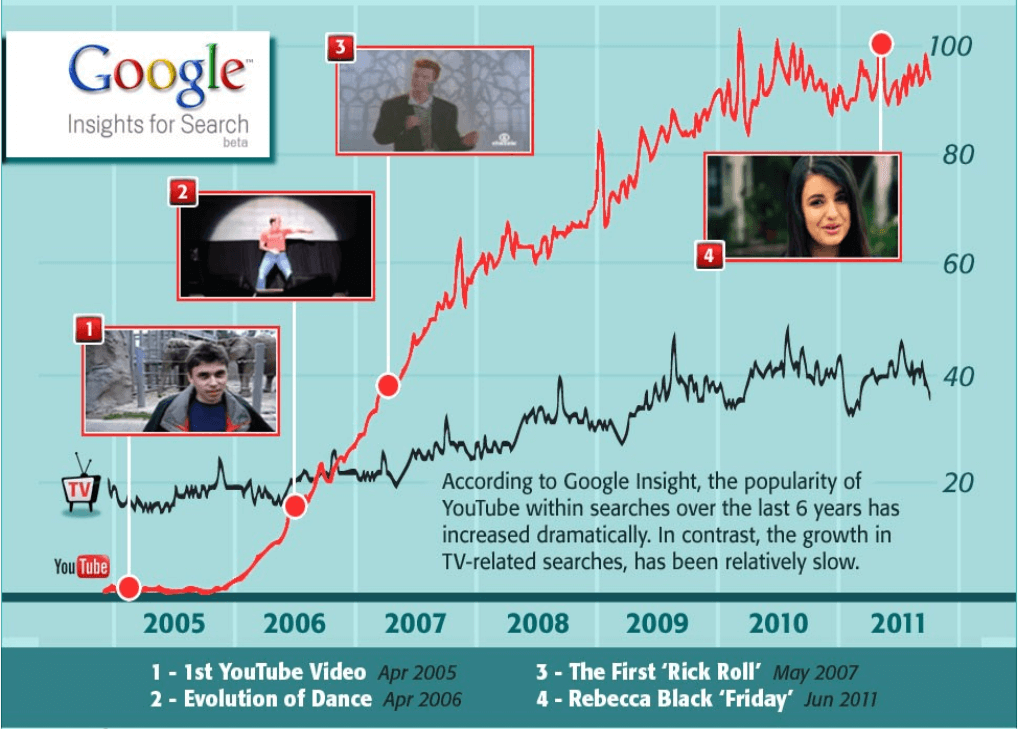
(don’t judge!)
We did produce a few projects for my own sites and for people I knew before that but YouTube Killed TV was the first campaign we launched for an actual lead that contacted us through our site.
All this to say that NeoMam will be officially 10 years old in 2021 :-O
I decided to celebrate this milestone by sharing some of the lessons I have learned throughout my journey.
These are all things that I would have loved to have known 10 years ago – although I’m sure 25-year-old me would have skimmed the post and thought ‘this guy doesn’t know anything’.
1. Invest in a Good Website Early on

Our first website was built on top of a free WordPress theme. It allowed us to get the site going quickly but too many years went by before we invested any serious time/money into a redesign.
Over the years we brought in multiple freelancers and even other agencies to help with the design and development of neomam.com. But it never really worked the way we were hoping, so we knew that eventually we would need to carve out time to do the job ourselves.
I wish we had done that a lot sooner as we learnt a ton and it really forced us to think about the impression we wanted to give potential clients and team members.
The biggest issue we faced is that we were not great at writing sales copy. I hated all the jargon-filled stuff I saw on the standard “agency” website so it wasn’t a matter of just taking a site as reference.
I knew we had to learn more about writing copy that would cut through all that noise and would feel ‘very NeoMam’ at the same time. We needed a voice.
Two courses were super useful, both from Henneke Duistermaat:
- https://www.enchantingmarketing.com/copywriting-course/
- https://www.enchantingmarketing.com/about-us-guide/
Henneke’s courses helped me have the confidence to create an agency website that felt like it was unique to us, something that in turn helped attract the right clients whilst putting off those looking for something different.
2. Identify Your One Thing

Photo by Christopher Rusev
Find out what your one thing is and stick to it.
It’s easy to get caught in the trap of constantly expanding your service offering as existing clients start enquiring about new things. In the short term, it feels like it’s good for business so you go ahead and say yes – next step is to hire someone who can do this new thing you’ve never done before.
Soon enough, you become known as an agency that takes on lots of different projects. And clients learn that they will probably get you to do new things whenever they need them.
Your team grows and you suddenly find that you need to hire managers to own the areas of the agency you know nothing about. You end up with a long list of clients who come to you for bitty work.
In the best of cases, you can keep this up for some time and start dropping services that prove to be problematic. In the worst of cases, your agency is a jack of all trades, master of none.
When I decided to specialise, I had plenty of people telling me that I was crazy. Looking back today, I’m so glad that I stuck to my guns.
The obvious benefit of specialising is that you will level up your skills way faster than your full-service competitors. It’s easier to become the best at your one thing that it is to master 15 different services.
But the main benefit I saw at the sales stage. There’s two reasons why I say this:
- Your name will become synonymous with your one thing, making it easier for people to immediately think of you first when asked to recommend someone for the job.
- Potential leads will be able to qualify themselves a lot faster with little input from you, meaning that you will be having more conversations with people who are actually looking for what you’re selling.
If you are a generalist then you will have to compete with every other generalist out there, and trust me, they are many.
3. Create That Big Case Study Early On
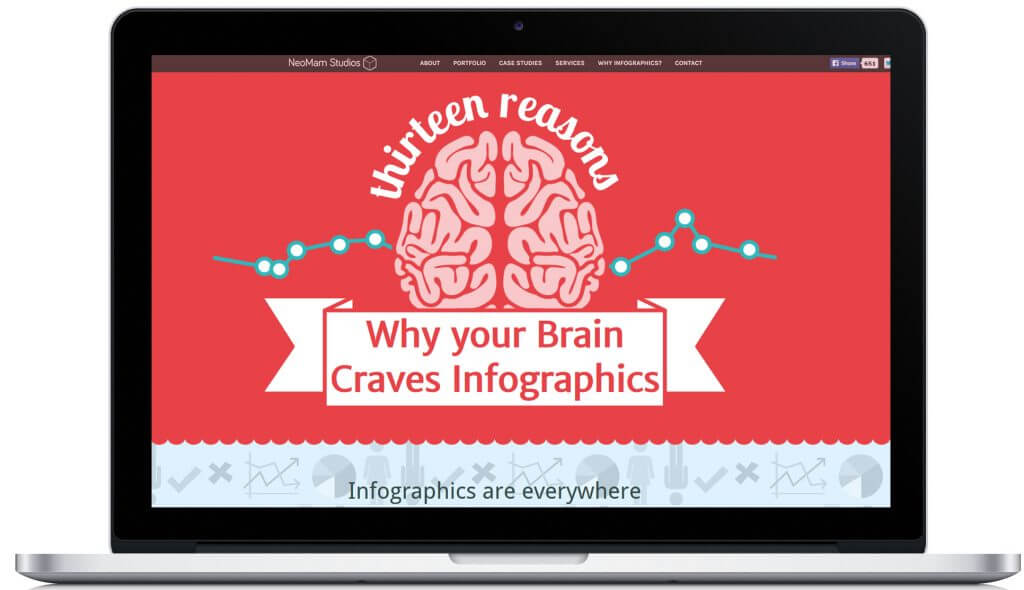
Achieving outstanding results with client work that can be converted into a case study is great, but it might not be something you can get done early on in your agency journey.
Even in cases where you get the results, sometimes clients are quite protective of the work and don’t want you to broadcast it all over your site.
So what is a new agency meant to do?
Do good work for yourself and create a case study with zero client restrictions to show the world what you’re all about.
Back in 2013, we caught the bug for interactive content but we didn’t have any client work to help us show others what we were able to do.
I made the decision to drop £5k on developing our own interactive experience and that’s how 13 Reasons Why Your Brain Craves Infographics was born.
This was way more than we could ever spend on a client campaign at that time but it enabled us to create something new that could also stand out from what was out there at the time.
Once we started promoting 13 Reasons, leads began to pour in as everyone wanted something like that for their site.
Not only that:
To date, that old interactive has attracted 1.54K referring domains and it regularly gets featured in SEO industry sites when discussing effective linkable assets (a.k.a. the stuff we make as an agency).
Big win all around.
4. Identify the Right Marketing Mix for Your Agency
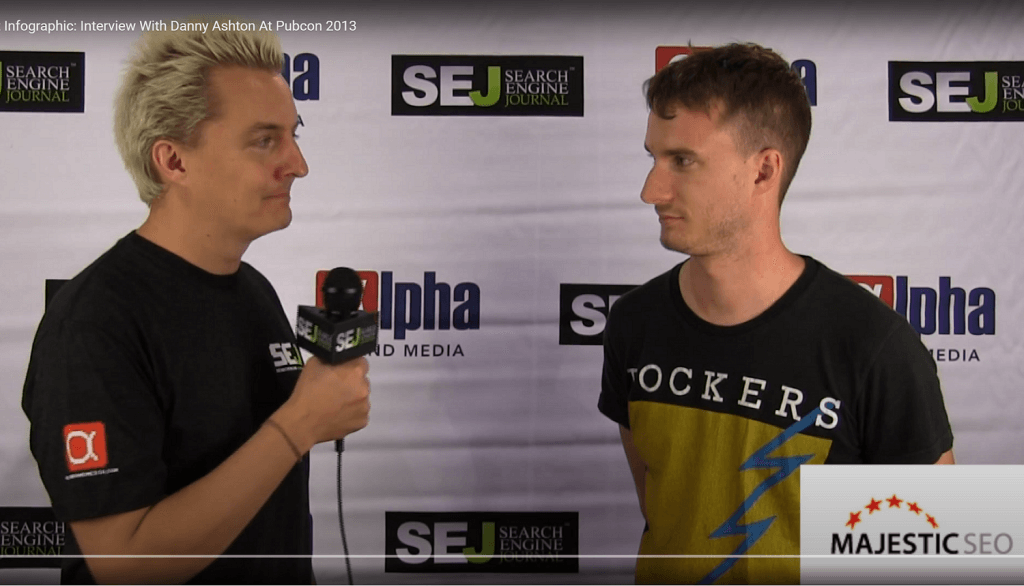
Photo by Murray Newlands
You will need to get the word out about your agency but don’t let it become your main focus.
In the early days, I used to attend events, speak at conferences, go to meetups and host training sessions. This meant that I kept super busy, mainly travelling between places.
It certainly wasn’t a total waste of time as I met lots of great people during that time. But looking back from where I am today, I can see that there was a lot of spinning wheels and getting nowhere.
The reality is that I was doing all these things to attract new business.
However, most of our trusted long-term clients came through one of two ways:
- They saw our work “in the wild” and got in touch with us directly, or
- I emailed someone who was working with another agency with a message saying “hey, I think we can do better”.
None of these clients attended events, joined webinars or were sending people to workshops hosted by agencies.
What they all have in common is that they want to see results.
Spending all your time in marketing the agency can feel like you’re doing something important. What is more, you can feel the instant reward as you see all the likes, retweets, upvotes, followers, gifts from tool companies, pitches for round-ups or invitations to speak at events… It’s a rush!
However, in my experience, you could drop 90% of all that marketing activity and still see the same amount of people getting in touch to work with you.
The key is to focus on the work that you’re putting out as an agency, leading to:
- Consistently good results that anyone can recognise
- Happy clients who stay with you long enough for others to take notice
If you pair that with a marketing message that clearly separates you from competitor agencies, you’ll find yourself marketing your business without even noticing it.
5. Not All Clients Are Created Equal

Animation by motion designer DeeKay Kwon
This is a piece of advice many founders gave me throughout the years: choose the right clients.
Of course, this is one of those tips that is easy to give but hard to apply. When you’re starting out, it feels like you don’t really have a choice: you need to work to pay the bills.
The problem is that if you’re not careful, you will find yourself a few years down the line and your mindset will not have changed. In my experience, this happens mainly because we get caught up with the short term gain ($$) and actively ignore the warning signs of a ‘problem client’.
What I couldn’t see clearly until a few years ago was the extent of the negative effects working with wrong clients can have on the agency as a whole:
- It can drain time away from the right clients
- It can get in the way of you actively looking for new clients (as you’re already busy with their work)
- It adds stress to every single person who works on the account
This last point to me is key. You might not be able to add a money figure to that added stress but it will make your agency less productive, less creative and less motivated to do good work.
All in all, working with the wrong client will stop you from making more money and enjoying the work while you’re at it.
- Pro tip: Whilst problem clients are clear from the start, so are clients who are a great fit. Stay focused on bringing results for them again and again and you will find yourself working with them for many years.
6. Good, Consistent Work Should Lead to Long-Term Contracts
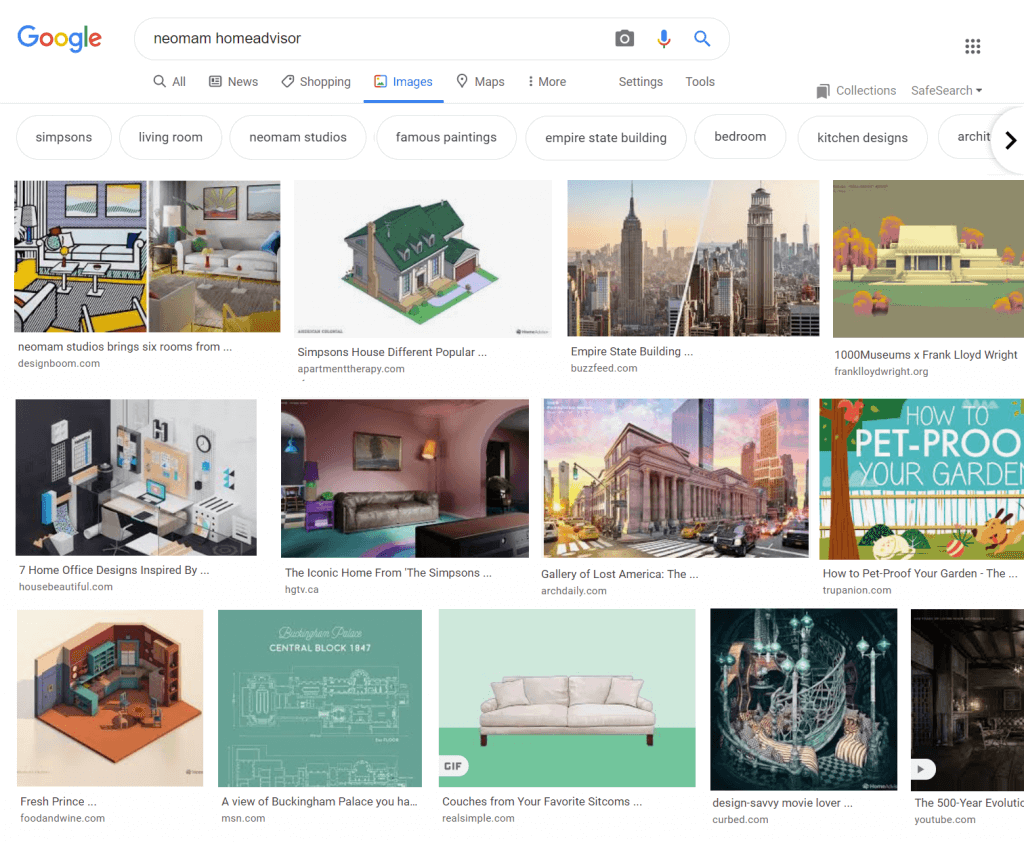
In the early days of NeoMam, 100% of our work was one-off projects. We didn’t think about retained work and just produced new work when the orders came in.
This was certainly simple to understand, easy to sell and clients loved the flexibility. But it was a major risk for the agency.
Taking orders like a takeaway meant that we were committed to clients who regularly ordered multiple projects without signing a contract with us. Yet we were forced to hire and train new staff to do the work for them, hoping that they would reorder in following months.
If I had my time again, I would put in place long-term agreements once a client had seen we could deliver what we set to achieve. This is the only way you can plan and forecast for the long run.
That being said, I do think that working on one-off project tests is important with new clients. There’s no way to know what a client will be like to work with other than doing some actual work for them. That’s why for us today, the initial test is where we spot red flags, and also where we build trust.
But the focus should always be about getting that long-term commitment and keeping those clients on your books for the long run.
7. You Are Probably Charging Too Little

Photo by Jared Poledna
This is one of those things I must have heard a hundred times but did little about.
When you are starting out, it’s natural to charge less in the hope that you will get the work.
The problem is that in many cases, clients who want to pay less will also want to take a lot more of your time.
My advice is this: Instead of increasing your prices to pump up your profit margins, increase them as a way to put off clients who are going to waste a lot of your time.
By doing this early on, you will avoid the challenge of moving old clients on to far higher prices in future – which is something that is possible to do but definitely not easy.
If I had my time again, I would have experimented with price a lot more in the early days to find a price that made sense to the right type of clients.
8. Be Wary of Shiny Things

Photo by Vinicius “amnx” Amano
Shiny things can be anything that takes your attention away from your core business.
Let me share an example:
Once we started getting good at design and ranking for terms like “infographic design” we started getting client enquiries from big organisations like Visa, Rio Tinto, Roche and even The United Nations.
The problem was that these guys didn’t want links. They wanted our team to create great looking design assets for their external and internal communications.
What we should have done was pass them on to someone who did this kind of thing. Instead, we wasted a couple years trying to do this type of work only to drop it when we eventually realised that it just wasn’t what we enjoyed.
Shiny things offer great potential returns but are not connected to your “one thing.” If everyone else is doing this new thing then it’s probably shiny and best to be avoided.
Having a clear vision is key to helping avoid shiny things that will eventually catch your interest and divert your attention from the big, hairy audacious goal you set out to achieve.
If we are using mental gymnastics to explain why a new idea aligns with our vision (creating content that people will want to share for months and years to come), then it’s probably shiny and would be best if we walk away from it.
9. Just Give Them the Money Back Already!
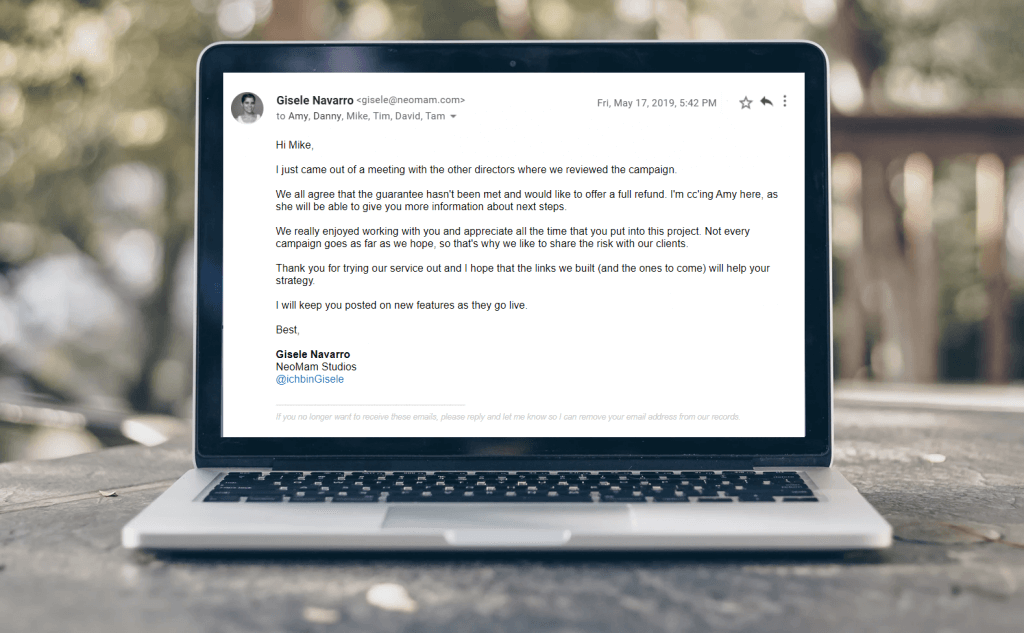
Refunding clients who are not a good fit is one of the things we have made a point of doing since pretty much day one.
This is one of the most important tips on this list:
Just give those clients their money back so you both can move on.
I totally get that you will have put money and/or time into a project but if it’s not working, then it’s on you for taking the project in the first place.
Just do the simple thing and give them their money back. Hopefully you will learn a lesson.
The money lost will become a situation to remember next time you are about to take on a client that you don’t have a good feeling about!
But it’s not just about letting go of clients who aren’t a good fit for your agency, it’s also about doing right for clients when your agency isn’t a good fit for them.
There have been times when our work didn’t meet our client’s expectations and in those cases, we always gave them their money back before we walked away. Although the situation sucks, it feels a lot better to know that you did the right thing and that the client didn’t have to pay for work they weren’t happy with.
Our industry is small so you really want to minimise the amount of people who are saying bad things about your agency.
10. Know When It’s Time to Let Someone Else Run the Agency

Photo by ian dooley
This lesson is a piece of news in disguise.
As a founder, I have taken this agency from an idea in my head to a desk in my house to an incubator funded by Manchester University to a small-room-turned-office on the side of the motorway to a fancy office in the Northern Quarter to a fully remote team working from home all over the world.
I’ve done this with the help of a handful of people throughout the years; some who are no longer part of NeoMam, others who are still core members of the team.
But most of the tough decisions that had to be made to take the agency from my head to where it is today were my decisions. With them the anxiety, the restless nights and everything that came with them.
Leading NeoMam hasn’t been easy. I’m not a natural managing director, the role of CEO doesn’t align with many aspects of my personality.
But as a founder, I always felt that it was my place to make these decisions and take on the responsibility that comes with running the agency.
Everything changed when I found myself dealing with the fact that we were a couple of months away from losing the agency.
We had to go back to basics and that meant all three directors (Amy, Gisele and I) going back to battle stations, to do the day-to-day work that goes into producing and promoting content.
For almost two years, all three of us worked together to service our clients at the same time that we were rebuilding NeoMam.
That’s when we started making these tough decisions together – Amy, Gisele and I. Suddenly, this idea of a founder who runs the business started to slip away.
Not only that, I also got back in touch with the things that got me excited about owning an agency in the first place: coming up with ideas for our campaigns and finding new clients.
This is where I will let you into a secret that probably won’t come as a shock to many people:
Gisele has been running the day to day of NeoMam for the past year or so.
It has been a natural evolution for us. All three directors still work closely together and make the hardest decisions as a team. But when it comes to keeping the fire burning, it’s been Gisele all along.
She’s brought clarity to how we work, why we do the things we do, where do we fit in our industry and what is next for our work. She’s also the team’s engine, keeping everyone engaged and connected to one another – constantly reminding everyone of our vision and reinforcing our company values.
After going through everything I’ve been through as the founder & CEO of NeoMam, it was time for me to take a step back so the agency can continue to grow while I spend my time doing what I truly enjoy doing and what I’m naturally great at.
Gisele has a very clear vision for NeoMam so I know that the agency is in great hands and I look forward to seeing what is in store for the next 10 years.
The lesson here is not to confuse the role of founder with that of an eternal boss, in charge of leading the agency every step of the way forever and ever.
You will always be the founder of your business and your vision will be imprinted into everything your team does. But when you find yourself not enjoying the job of leading or when your attachment to things being a certain way starts getting in the way, I would encourage you to consider whether you’re sitting in the right seat.
Be Open to Think Different
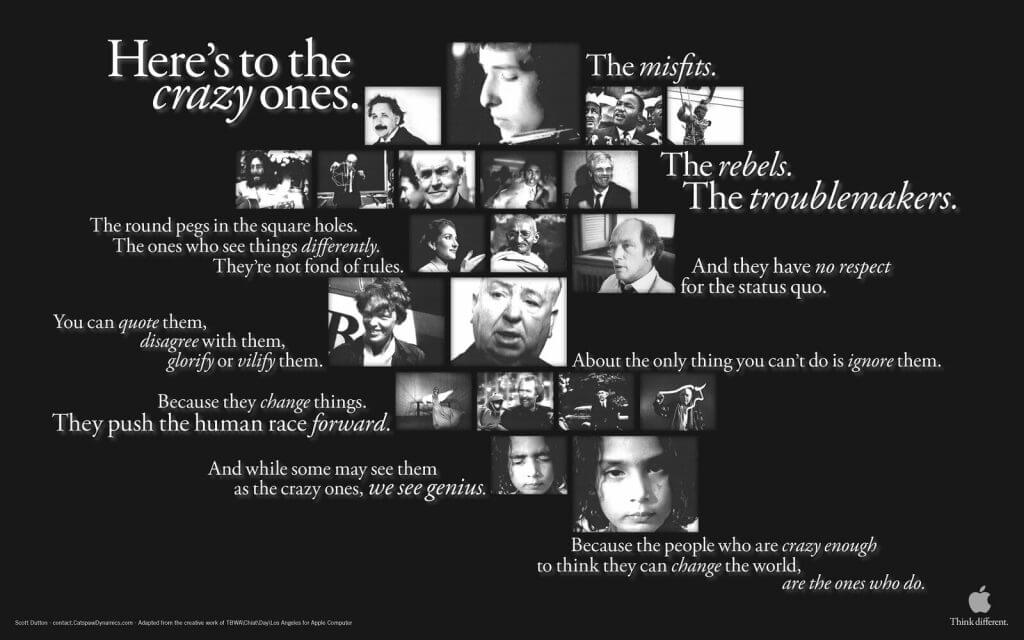
Some rights reserved by MarkGregory007
Many of the lessons I shared with you today come from decisions I made that went against the grain.
When I decided to specialise, I had people telling me I was making a mistake. When I chose to never sell the agency, I had people telling me it was a mistake. When I took myself out of the conference and events circuit, I had people telling me it was a mistake. When I decided to close the office and go fully remote, I had people telling me it was a mistake. The list goes on.
Whether it’s me or Gisele running the ship, one thing won’t change: we will continue to walk our own path, even when that means going against the norm.
Launching, growing and succeeding as an agency is not an easy feat. In my 10 years leading NeoMam, I’ve seen dozens of agencies being born, bought, merged, sold and closed down.
Differentiating your agency from competitors is key. You will find it hard to do if you’re blindly following what everyone else is doing and recommending.
Listen to all the advice you receive but stay true to yourself.
Ps. I’m writing this for the new generation of agency founders. If that is you and you’ve got any questions or need guidance, feel free to connect with me: https://www.linkedin.com/in/dannyashton/ (my inbox is always open)